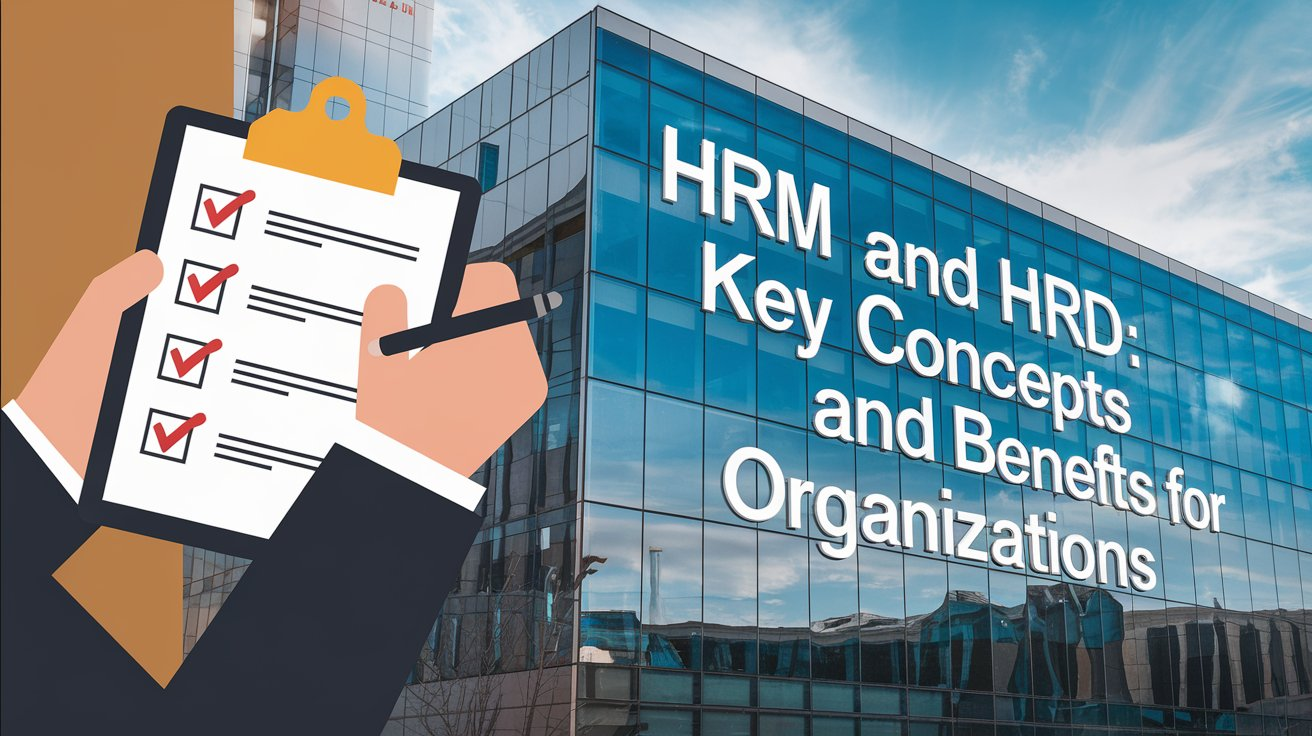Organizations must prioritize effective human capital management and development to thrive in today’s competitive business landscape. Two essential concepts in this domain are Human Resource Management (HRM) and Human Resource Development (HRD). Understanding the roles and benefits of these concepts helps organizations harness their workforce’s full potential and achieve strategic objectives. This article explores the key concepts and benefits of HRM and HRD and how they contribute to organizational success.
Understanding Human Resource Management (HRM)
Human Resource Management (HRM) involves overseeing and managing the various aspects of an organization’s human resources. This includes recruitment, training, performance management, employee relations, and compliance with labor laws. HRM focuses on aligning human resources with organizational goals to ensure efficient operations and a productive work environment.
HRM is a strategic approach that integrates various HR functions to manage the workforce effectively. It emphasizes planning, implementing, and evaluating HR practices that support business objectives. By establishing policies and practices that address employee needs and organizational goals, HRM plays a pivotal role in driving organizational performance and employee satisfaction.
Exploring Human Resource Development (HRD)
Human Resource Development (HRD) is a subset of HRM focused on the growth and development of employees. It encompasses training, career development, and organizational development activities aimed at enhancing employees’ skills, knowledge, and abilities. HRD aims to equip employees with the competencies required to perform their roles effectively and advance within the organization.
HRD involves a range of activities, including:
- Training Programs: Designed to improve employees’ skills and knowledge related to their current roles.
- Career Development: Helping employees plan and achieve their career goals through mentorship, coaching, and development opportunities.
- Organizational Development: Implementing strategies to improve organizational effectiveness, culture, and processes.
Key Differences Between HRM and HRD
While HRM and HRD are interrelated, they serve distinct purposes within an organization. The difference between HRM and HRD lies in their focus and objectives:
- HRM is primarily concerned with managing day-to-day HR functions and ensuring that HR practices align with organizational goals. It deals with administrative aspects such as recruitment, compensation, and compliance.
- HRD, on the other hand, focuses on employee development and organizational growth. It aims to enhance employees’ skills and capabilities to support their personal and professional growth.
Both HRM and HRD are essential for creating a thriving workplace environment, but they address different aspects of human resource management. Combining effective HRM practices with comprehensive HRD strategies can lead to improved employee performance, higher job satisfaction, and greater organizational success.
Benefits of Integrating HRM and HRD
Integrating HRM and HRD offers several benefits to organizations:
Enhanced Employee Performance
Combining HRM and HRD practices leads to better-trained and more skilled employees. By investing in both effective management and development initiatives, organizations can improve employee performance and productivity. Training programs and career development opportunities help employees stay motivated and perform their tasks more efficiently.
Increased Employee Retention
Organizations that focus on both HRM and HRD are more likely to retain their top talent. Providing opportunities for professional growth and a supportive work environment helps in reducing turnover rates. Employees are more inclined to stay with an organization that values their development and offers career advancement opportunities.
Improved Organizational Efficiency
Effective HRM ensures that HR functions are streamlined and aligned with organizational goals. HRD initiatives contribute to a more capable and adaptable workforce. This combination results in improved organizational efficiency and effectiveness, enabling the organization to respond better to changes and challenges in the business environment.
Stronger Organizational Culture
A well-integrated HRM and HRD approach fosters a positive organizational culture. HRM practices help in creating a structured environment, while HRD initiatives promote continuous learning and development. Together, they contribute to a culture of growth, collaboration, and mutual respect.
Strategic Alignment
Integrating HRM and HRD ensures that human resource activities are aligned with the organization’s strategic objectives. This alignment helps in achieving business goals and supporting long-term success. By focusing on both effective management and development, organizations can build a workforce that contributes to their strategic vision.
Role of a Human Resource Service Provider
Organizations often partner with a Human Resource Service Provider to manage and enhance their HRM and HRD practices. These providers offer expertise in various HR functions, including recruitment, training, and compliance. They help businesses implement effective HR strategies, develop customized training programs, and manage HR-related challenges.
A Human Resource Service Provider can offer valuable support in:
- Implementing HR Strategies: Developing and executing HR strategies that align with organizational goals.
- Providing Expertise: Offering specialized knowledge and experience in HRM and HRD.
- Managing HR Functions: Handling various HR tasks and processes to ensure efficiency and compliance.
- Supporting Employee Development: Designing and delivering training programs that address specific needs.
Integrating HRM and HRD for Business Efficiency
In summary, Human Resource Management (HRM) and Human Resource Development (HRD) are crucial for achieving organizational success. While HRM focuses on managing HR functions and aligning them with business objectives, HRD emphasizes the growth and development of employees. Understanding the difference between HRM and HRD and integrating these practices can lead to enhanced performance, increased employee retention, and improved organizational efficiency. Partnering with a Human Resource Service Provider can further support the effective implementation of HR strategies and development initiatives, contributing to long-term business success.
Pigeon Polypropylene Mini Handy and Compact Chopper with 3 Blades for Effortlessly Chopping Vegetables and Fruits for Your Kitchen (12420, Green, 400 ml)
₹199.00 (as of 19 September, 2024 18:22 GMT +05:30 - More infoProduct prices and availability are accurate as of the date/time indicated and are subject to change. Any price and availability information displayed on [relevant Amazon Site(s), as applicable] at the time of purchase will apply to the purchase of this product.)ALOXE Cosmetic Organizer Box Drawers Storage Plastic Stationary Box | Make Up Organiser For Women
₹284.00 (as of 19 September, 2024 18:22 GMT +05:30 - More infoProduct prices and availability are accurate as of the date/time indicated and are subject to change. Any price and availability information displayed on [relevant Amazon Site(s), as applicable] at the time of purchase will apply to the purchase of this product.)Air Wick 250 ml - Vanilla & Muskmelon (Summer Delights), Refill + Automatic Spray| Freshmatic Air Freshener Kit | 2600 Sprays Guaranteed | Automatic Room Freshener, Bathroom Freshener and Room Spray
₹413.00 (as of 19 September, 2024 18:22 GMT +05:30 - More infoProduct prices and availability are accurate as of the date/time indicated and are subject to change. Any price and availability information displayed on [relevant Amazon Site(s), as applicable] at the time of purchase will apply to the purchase of this product.)Claiez Fridge Storage Boxes Freezer Storage Containers, Container for Kitchen Storage Set, Storage in Kitchen, Vegetable Storage, Draining Crisper Refrigerator Food Box (1200 ML-8 pc)/
₹449.00 (as of 19 September, 2024 18:09 GMT +05:30 - More infoProduct prices and availability are accurate as of the date/time indicated and are subject to change. Any price and availability information displayed on [relevant Amazon Site(s), as applicable] at the time of purchase will apply to the purchase of this product.)SHAYONAM 3IN1 Portable Car Vacuum Cleaner with Blower | USB Rechargeable Wireless Handheld Car Vacuum Cleaner Traveling, Camping Reusable,Portable,Rechargeable (Vacuum with Blower)(Multy)
₹699.00 (as of 19 September, 2024 18:09 GMT +05:30 - More infoProduct prices and availability are accurate as of the date/time indicated and are subject to change. Any price and availability information displayed on [relevant Amazon Site(s), as applicable] at the time of purchase will apply to the purchase of this product.)Discover more from The General Post
Subscribe to get the latest posts sent to your email.





